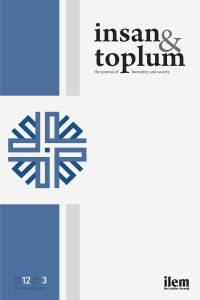Sınır Sosyolojisi Perspektifinden Theo Angelopoulos’un “Sınır Üçlemesi”
Bu çalışmada Yunan yönetmen Theo Angelopoulos’un sınır üçlemesi olarak bilinen Leyleğin Geciken Adımı (1991), Ulis’in Bakışı (1995) ve Sonsuzluk ve Bir Gün (1998) adlı filmleri sınır sosyolojisi bağlamında ele alınmaktadır. Diğer birçok filmi çeşitli akademik çalışmalara konu edilmesine rağmen bu filmlerinin sosyoloji, özellikle de sınır sosyolojisi bağlamında incelenmediği görülmüştür. Özellikle günümüzde sınır, göç ve mültecilikle gittikçe daha yoğun bir biçimde karşılaşılıyor olması sınır üçlemesi üzerinde durulmayı gerektirmektedir. Çalışmada üçlemedeki başlıca temalar sınır sosyolojisi literatürü göz önünde bulundurularak belirlenmiştir. Bu çerçevede, modern sınırların böldüğü akraba topluluklardan sınırın şiddet biçimlerine, mültecilerin yaşam koşullarından ev sahibi toplumların onlara bakışına kadar birçok tema belirlenmiş ve ilgili literatür bağlamında yorumlanmıştır. Sonuç olarak sınır üçlemesinde; sınırların nasıl adaletsizliğin, şiddetin, dışlamanın, milliyetçi nefretin araçları ve birlikte yaşamanın önünde engeller olduğunu görmekteyiz. Dolayısıyla Angelopoulos’un sınıra, mülteciye ve yabancıya ne ulus-devletçi ne de ulus cemaatçi açıdan baktığını söyleyebiliriz.
Theo Angelopoulos’ “Trilogy of Borders” from the Perspective of Border Sociology
In this study, the films of Greek director Theo Angelopoulos, known as the border trilogy, The Suspended Step of the Stork (1991), Ulysses’ Gaze (1995) Eternity and a Day (1998), are discussed in the context of border sociology. Although many of his other films have been the subject of various academic studies, it has been observed that these films have not been studied in the context of sociology, especially border sociology. Especially today, the fact that borders, migration and refugees are increasingly encountered requires focusing on the border trilogy. In the study, the main themes in the trilogy were determined by considering the literature of border sociology. In this framework, many themes, from kinship communities divided by modern borders, to forms of border violence, from the living conditions of refugees to the perspective of host societies, have been identified and interpreted in the context of the relevant literature. As a result, in the border trilogy, we see how borders are tools of injustice, violence, exclusion, nationalist hatred and obstacles to living together. Therefore, we can say that Angelopoulos does not look at the border, the refugee and the foreigner from a nation-state or nation-community perspective.
___
- Kolossow, V. (2005). Border studies: Changing perspectives and theoretical approaches. Geopolitics, 10, 606–632.
- Kurczewska, J. (2009). Border metaphors in the Polish sociology of borderlands. Polish Sociological Review, 2 (166), 193-212.
- Mansbach, R. W. & Wilmer, F. (2001). War, violence, and the Westphalian state system as a moral community. M. Albert, D. Jacobson & Y. Lapid (Ed.). Identities, borders, orders içinde, ss. 51-71. University of Minnesota Press.
- Özbey, K. (2018). Karşılaştırmalı tarihsel sosyoloji perspektifinden sınır, mekân ve bellek: Sarp Köyü örneği. Gaziantep University Journal of Social Sciences, 17 (4), 1398-1414.
- Özgen, H. N. (2005). Sınırın iktisadi antropolojisi: Suriye ve Irak sınırlarında iki kasaba. B. Kümbetoğlu & H. B. Gedik (Ed.). Gelenekten Geleceğe Antropoloji içinde, s. 100-128. Epsilon Yayıncılık.
- Sağıroğlu, A. Z. (2021). Korku çağı: Terör, salgın ve mülteciler. İnsan & Toplum 11 (4), ss. 201-228.
- Schulz, G. (2006). Soluk alıp verir gibi çekerim: Sonsuzluk ve Bir Gün. Theo Angelopoulos, D. Fainaru (Der.) içinde, M. Harmancı (Çev.). ss. 144-139. Agora Kitaplığı.
